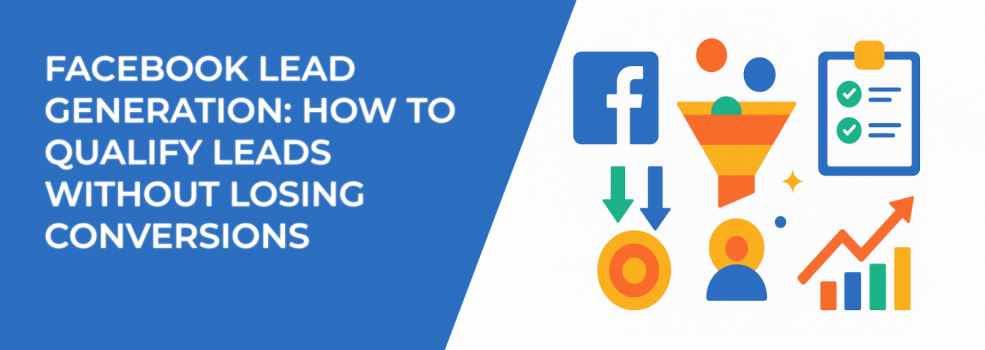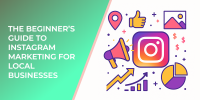Running Facebook lead generation campaigns often starts with excitement. You launch the ads, set up the form, and watch the leads pour in. At first glance, the numbers look strong. But then sales teams step in and frustration begins: many leads are unresponsive, unqualified, or flat-out uninterested.
This is the classic Facebook lead generation trap. The platform makes it incredibly easy to capture details, but the simplicity works both ways. Just as you can collect more leads faster, you can also end up with lower intent and lower quality if you’re not careful.
That’s why qualification is the balancing act every advertiser has to master. Too broad, and you fill your pipeline with junk. Too strict, and you pay a premium for a trickle of contacts. The real skill lies in designing systems that qualify leads without killing your conversion rates.
Why Qualification Defines ROI
Think of your marketing funnel as plumbing. If the pipes are wide open, water rushes through — but it carries debris with it. If the pipes are too narrow, water trickles out slowly. Your job is to regulate flow so you get volume, but only of what’s useful.
Leads are never free. Whether you’re paying $2, $20, or $200 per lead, the question is whether they convert into actual revenue. Without qualification, your reporting may look impressive — thousands of leads at low cost per lead (CPL). But when those leads don’t convert, your cost per acquisition (CPA) skyrockets.
Scenario:
-
Advertiser A spends $2,000 and gets 400 leads ($5 CPL). Only 5 close, meaning CPA is $400.
-
Advertiser B spends the same amount, collects 200 leads ($10 CPL), but 25 close. CPA is $80.
Advertiser B looks worse if you only check CPL. But they actually outperform because they qualified their funnel.
This is why qualification isn’t optional — it directly impacts return on ad spend (ROAS). If you’ve ever struggled with campaigns that bring in volume but no sales, you’ll find useful troubleshooting steps in Facebook Ads Not Converting: How To Fix It.
Step 1: Define “Qualified” Before You Collect
Too many advertisers start building Facebook campaigns without answering the most important question: What makes a lead worth pursuing?
This definition depends entirely on your business. A high-ticket B2B SaaS tool has very different needs than a local restaurant. A real estate agent looking for motivated buyers has different qualification rules than an e-commerce store looking for repeat shoppers.
Here are the most common dimensions:
-
Budget — If your lowest package costs $5,000, you don’t want leads who can only spend $500.
-
Timeline — Leads who want a solution in the next 30 days may be far more valuable than those just “exploring options.”
-
Job Role or Authority — A marketing intern filling your form isn’t as valuable as the CMO who can actually approve spending.
-
Location — A lead in another country doesn’t help if you can only deliver services locally.
Example 1: A SaaS company offering enterprise software doesn’t want students downloading free demos. They add a “Company size” question to weed out individuals.
Example 2: A mortgage broker asks “When do you plan to buy?” and prioritizes anyone answering “within 3 months.”
Tip: Interview your sales team. Ask them what patterns they see in bad leads. Those red flags should become your qualifying filters.
If you’re not sure how to structure this, check How to Define a Target Audience for Marketing: a Step-by-Step Guide. It breaks down a framework for identifying the right people before you launch a campaign.
Step 2: Use Facebook Targeting With Precision
Facebook’s targeting options are powerful, but many advertisers either underuse them or overuse them. Going too broad (like targeting “all adults in the U.S.”) may give you cheap leads, but quality plummets. Going too narrow (like targeting only “Marketing Managers at SaaS companies in Austin”) might give you high quality, but your costs will explode.
The sweet spot is layering intelligently.
-
Custom Audiences — Retarget people who already know you (website visitors, email lists). They often cost less to convert because trust is already built.
-
Lookalike Audiences — Scale by cloning your best customers. For example, create a 1% lookalike based on your paying subscribers, not just anyone who visited your homepage.
-
Exclusions — One of the most underrated features. If you’re running lead gen ads for a service, exclude current customers and competitors to avoid wasted spend.
Scenario: A coaching business ran ads to a broad audience of “entrepreneurs.” CPL looked good, but many were students or side hustlers with no budget. After excluding people under 25 and layering interests like “business consulting,” lead quality improved by 45%.
Targeting isn’t about reducing audience size. It’s about sharpening relevance so you don’t pay to attract people who will never buy. You’ll find practical strategies in Facebook Ad Targeting 101: How to Reach the Right Audience.
Step 3: Design Lead Forms That Balance Quantity and Quality
Facebook Lead Ads auto-fill details like name, email, and phone — which is great for convenience but also means users can sign up with one click, even if they’re not really interested. This explains why unqualified leads are so common.
That’s why form design matters more than most realize. Too short, and you’ll drown in noise. Too long, and you scare away the right people. The answer is balance.
Tips for smarter forms:
-
Add one deal-breaker question. For example: “What’s your budget range?” or “When do you plan to start?”
-
Use multiple choice instead of open text. This avoids messy data and speeds up completion.
-
Test form length. Short forms usually convert higher, but long forms often qualify better. The trick is running A/B tests to find your “conversion threshold.”
Example:
-
A real estate agent uses a 3-question form (name, email, phone). They get 1,000 leads but only 20 are serious buyers.
-
They switch to a 6-question form asking budget, location, and move-in timeline. Lead volume drops to 600, but now 120 are serious buyers.
The second version generates fewer leads, but more sales-ready ones.
Pro tip: Use conditional logic. If a lead selects “Budget under $500,” the form can end early, saving both you and them wasted time.
Step 4: Speed and Personalization in Follow-Up
Even the most qualified lead goes cold if you don’t act fast. Data shows contacting a lead within 5 minutes makes them up to 9x more likely to convert. The longer you wait, the less they remember you — and the less they care.
Best practices for follow-up:
-
Automate CRM sync. Use tools like Zapier, HubSpot, or Salesforce integrations to push leads directly from Facebook into your system.
-
Send instant confirmations. A quick SMS or email saying “Thanks, we’ll be in touch soon” keeps you top of mind.
-
Score leads dynamically. Track whether they opened emails, clicked links, or replied quickly. Use these signals to decide who gets priority outreach.
Scenario:
-
Business A waits 24 hours to call back. By then, the lead has filled out three other competitors’ forms.
-
Business B calls within 10 minutes, while the prospect is still in research mode. They close the deal before anyone else even reaches out.
The takeaway? Speed is qualification’s best friend. Even a “so-so” lead can convert if you’re the first to respond. For practical timing tactics, see How to Finish the Facebook Learning Phase Quickly.
Step 5: Go Beyond Forms — Use Conversational Ads
Lead forms aren’t the only way to collect and qualify information. Messenger and WhatsApp ads are growing because they feel interactive, not transactional.
Here’s how they work:
-
Start simple. Ask an easy yes/no or multiple-choice question to hook the user.
-
Layer with 2–3 filters. For example, “What’s your budget?” or “Are you looking to start within 30 days?”
-
Qualify in real time. If someone answers “no budget,” you can stop there and avoid wasting sales effort.
Example: A fitness coach ran Messenger ads asking, “Are you looking to join a program this month?” Those who answered “yes” went into her CRM. Those who answered “no” were filtered out instantly. This reduced wasted leads by 60%.
Conversational ads may not replace lead forms entirely, but they’re powerful as a pre-qualification layer — especially for businesses that value dialogue.
Step 6: Analyze and Iterate Like a Scientist
No campaign works perfectly forever. That’s why iteration is non-negotiable. You need to constantly ask: are the leads converting? If not, where is the breakdown?
Metrics to track:
-
Sales acceptance rate. What % of leads does your sales team agree are worth pursuing?
-
Cost per acquisition (CPA). Focus on how much it costs to close a customer, not just to capture a lead.
-
Lead-to-customer conversion rate. How many leads actually turn into revenue?
Example:
-
Campaign 1 collects 1,000 leads at $5 each ($5,000 total). Only 3% convert, so CPA is $167.
-
Campaign 2 collects 600 leads at $8 each ($4,800 total). But 8% convert, so CPA is $100.
Even though Campaign 2 has fewer leads, it produces better ROI.
Iteration means testing new targeting, experimenting with form length, adjusting follow-up scripts, and even redefining what “qualified” means over time. For more advanced ideas, check Mastering Lead Generation in 2025: Top Tactics for Success.
Final Thoughts
Facebook lead generation is easy. Facebook lead qualification is hard. But qualification is what turns lead lists into sales pipelines.
If you want to win, you need to:
-
Define what “qualified” means for your business.
-
Use Facebook targeting with precision.
-
Balance your lead forms to filter smartly without scaring prospects away.
-
Follow up fast and personally.
-
Experiment with conversational ads.
-
Analyze and refine continuously.
Advertisers who take this approach don’t just collect data — they collect customers. And that’s the difference between wasting ad spend and building predictable growth.

